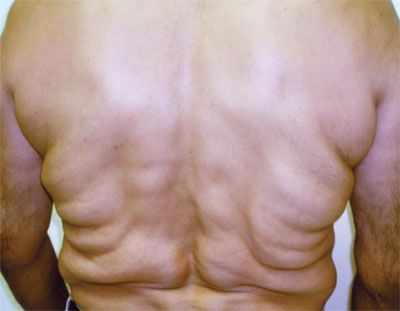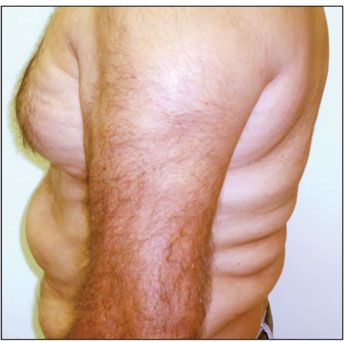- Clinical Technology
- Adult Immunization
- Hepatology
- Pediatric Immunization
- Screening
- Psychiatry
- Allergy
- Women's Health
- Cardiology
- Pediatrics
- Dermatology
- Endocrinology
- Pain Management
- Gastroenterology
- Infectious Disease
- Obesity Medicine
- Rheumatology
- Nephrology
- Neurology
- Pulmonology
Multiple Symmetric Lipomatosis
The multiple, symmetrically distributed, soft, nontender swellings on the shoulders and torso of a 56-year-old Hispanic man are characteristic of multiple symmetric lipomatosis (MSL), also known as Madelung disease or Launois- Bensaude syndrome.
The multiple, symmetrically distributed, soft, nontender swellings on the shoulders and torso of a 56-year-old Hispanic man are characteristic of multiple symmetric lipomatosis (MSL), also known as Madelung disease or Launois- Bensaude syndrome.

The patient also had lipomas in the upper thighs, neck, and occipital areas. He underwent surgical removal of 2 occipital lipomas and 1 in the posterior neck. One of the occipital lipomas had been previously excised but had recurred and, within 6 years, had grown to its original size. During the excision, no distinct capsule was noted. The lipomas extended into the deep fascial layers.
Other than an elevated aspartate aminotransferase (AST) level, all other laboratory results were normal. A CT scan of the chest and abdomen showed no intrathoracic or intra-abdominal fatty deposits and no evidence of internal malignancy.
MSL predominantly affects middle-aged men of Mediterranean origin.1 The disease is characterized by diffuse accumulation of painless unencapsulated lipomas most commonly located in the subcutaneous tissue of the cervical, deltoid, thoracic, abdominal, and lumbar regions. Because of the symmetry of the masses, the condition is often mistaken for obesity, although the uninvolved areas in patients with MSL may appear emaciated by contrast.
MSL has been divided into 3 types: type 1 involves the neck region; type 2 involves the entire upper trunk, including chest and shoulders, which creates a pseudoathletic appearance-as seen in this patient; and type 3 primarily involves the thighs (gynecoid type).
Excessive ethanol intake, especially red wine, is commonly associated with MSL. This patient had a history of alcohol abuse, which may explain his elevated AST level. Other associations are increased blood pressure, dyslipidemia, gout, decreased insulin sensitivity leading to impaired glucose tolerance or sometimes frank diabetes, hyperleptinemia and renal tubular acidosis, and peripheral motor-sensory or autonomic neuropathy.2-5 Obstructive sleep apnea has also been described, especially in type 1 MSL.2
MSL must be distinguished from other forms of fatty tumor deposition in the subcutaneous tissues. Of these, Dercum disease, which primarily affects obese postmenopausal women and consists of painful fatty tumors, is the most important.

Lifestyle modification in the form of diet and exercise and abstinence from alcohol can reverse the metabolic abnormalities but may not affect the size or progression of the lipomas. In one study, oral salbutamol showed significant therapeutic effect.6
Unlike isolated lipomas, which are capsulated and easily excised, surgical removal of the lipomatous masses of MSL is complicated, and recurrence after surgery is common. Thus, surgical excision is only advocated for those with functional impairment or emotional stress from disfigurement. Liposuction is another option that can provide temporary relief.
References:
REFERENCES:1. Chuang CC, Cheng YF, Chang HP, Lin CZ. Madelung’s disease. J Chin Med Assoc. 2004;67:591-594.
2. Harsch IA, Schahin SP, Fuchs FS, et al. Insulin resistance, hyperleptinemia, and obstructive sleep apnea in Launois-Bensaude syndrome. Obes Res. 2002;10:625-632.
3. Greene ML, Glueck CJ, Fujimoto WY, Seegmiller JE. Benign symmetric lipomatosis (Launois-Bensaude adenolipomatosis) with gout and hyperlipoproteinemia. Am J Med. 1970;48:239-246.
4. Wilson D, Boland J. Sporadic multiple lipomatosis: a case report and review of the literature. W V Med J. 1994;90:145-146.
5. Enzi G, Busetto L, Ceschin E, et al. Multiple symmetric lipomatosis: clinical aspects and outcome in a long-term longitudinal study. Int J Obes Relat Metab Disord. 2002;26:253-261.
6. Leung NW, Gaer J, Beggs D, et al. Multiple symmetric lipomatosis (Launois-Bensaude syndrome): effect of oral salbutamol. Clin Endocrinol (Oxf). 1987;27:601-606.
